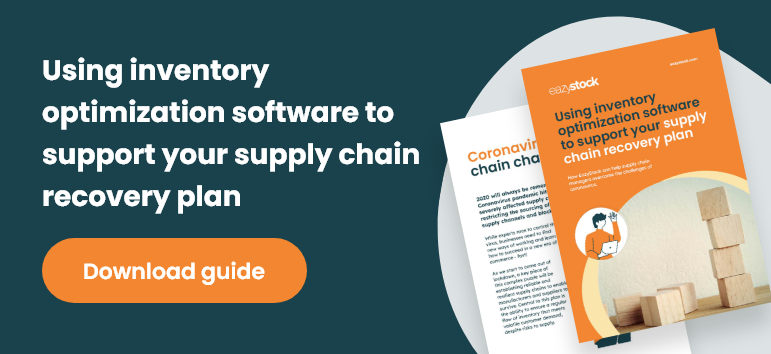COVID-19: Managing Supply Chain Risk and Disruption
In our four-part blog series on Coronavirus and its impact on inventory management, so far we’ve looked at how to overcome COVID-19 demand forecasting challenges and improving inventory planning during the pandemic. Now we’re going to focus on mitigating the risks of supply chain disruption as we move out of lockdown and into a new, but uncertain, future.
Global supply chain disruption due to COVID-19
When the COVID-19 pandemic emerged earlier this year, many businesses saw instant disruption to their supply chains. With sudden demand shifts for everything from food to home office supplies to hand sanitizer combined with shipping and distribution disruptions, supply chains need to build resilience to survive.
 Many countries in Asia and Europe are beginning to slowly recover from the Coronavirus with lockdowns easing at different rates. As this happens, suppliers will begin to ‘return to normal’ and lead times will start to fall. But at the same time, there is still uncertainty around how global supply chains will perform in the future.
Many countries in Asia and Europe are beginning to slowly recover from the Coronavirus with lockdowns easing at different rates. As this happens, suppliers will begin to ‘return to normal’ and lead times will start to fall. But at the same time, there is still uncertainty around how global supply chains will perform in the future.
For starters, the time it will take businesses to reach their full operational capacity is going to vary from country to country. And, even when supply returns, there’s always a chance it could dry up again if the virus takes hold once more. We could, therefore, see months of disruption.
Many experts are predicting that there will be a shift from globalized to regionalized supply chains to mitigate the risks surrounding single-supply with businesses looking for greater flexibility in how they source their inventory. However, with such a complex network of suppliers and sub-suppliers already in place across Asia, this could be an extremely difficult challenge.
Looking to the future, it will be critical to build agile and responsive supply chains that can adapt when things get tough. At the heart of such a model is the need for operational transparency and data-led decision-making.
Here’s some ideas on how to make this happen…
Supplier management in a post COVID-19 market
Supplier communication
Whether you choose to grow your supplier network or maintain existing relationships, in the future it’s going to be more important than ever to build and nurture strong partnerships with your suppliers.
These relationships rely on three key pillars: data, communication and transparency.
The more data you can give suppliers about your future demand and order requirements the better. You can then have regular, open and honest communication with them at all levels of your business. In return, they should be sharing details around their current and future risks to supply. Understanding how reliant they are on their suppliers and working down each tier of the supply chain will give you complete transparency and the chance to highlight potential bottlenecks.
EazyStock is able to support this process in a number of ways:
First, it gives you a wealth of easily accessible data about your inventory – down to SKU level. This can help you understand your current stock positions in terms of available stock to meet demand, excess stock, obsolete stock and stock at risk of run-out.
Secondly, it can assist with demand forecasting. Right now, forecasting is extremely difficult, because in many cases historical demand data, usually used to calculate future projections, is heavily skewed due to surges or droughts in sales (dependent on the industry). EazyStock however, has a range of functionality to support with demand forecasting challenges during and post-Coronavirus.
One such tool is its order scheduling capabilities. This creates a demand projection that can be sent to suppliers, so they have a clear picture of your requirements e.g. what stock you need delivering and by when. If suppliers can provide potential lead times, these can be added to make the prediction even more realistic. Armed with this information, it’s then the responsibility of both parties to agree whether these expectations can be met, and, if not, what can be achieved.
Adjusting replenishment calculations for variable lead times
As your suppliers ‘return to work’, delays to supply will be inevitable as manufacturing levels take time to regain momentum and transportation routes take time to reopen. Having full visibility of lead time performance will be key to mitigating the impact on fulfillment.
 While some enterprise resource planning (ERP) or warehouse management systems (WMS) have the functionality to take supplier lead times into account when calculating reorder points or quantities, they rely on you manually updating the lead times – and with such variability right now, this could be a regular task!
While some enterprise resource planning (ERP) or warehouse management systems (WMS) have the functionality to take supplier lead times into account when calculating reorder points or quantities, they rely on you manually updating the lead times – and with such variability right now, this could be a regular task!
However, using EazyStock’s dynamic lead time feature, you can track actual lead times and receive alerts when they begin to deviate from the norm. You can then choose whether to simply receive and monitor the alerts, or to allow the system to automatically adjust replenishment parameters e.g reorder points and quantities, safety stock, etc, for specific items. With reordering calculations continually adjusting for changes to your supplier lead times, your ability to hit service levels or fulfillment targets substantially increases.
Supplier performance and optimization
Many organizations are expanding their portfolio of suppliers to help mitigate future supply risks. However, this brings another new challenge: identifying the most efficient supplier to use, which often involves balancing unit costs with delivery speed and reliability.
EazyStock’s supplier optimization functionality helps inform these decisions by letting inventory teams compare suppliers based on their lead times, unit prices and minimum order quantities (MOQs). Usually, lower unit prices are achieved at the expense of longer lead times and higher MOQs (leading to higher carrying costs). But, with COVID-19 impacting all three variables, this rule may no longer apply. For some items it may be wiser to pay more for shorter lead times to prevent a stockout.
When an order is ready to place, EazyStock will recommend the supplier that can deliver in time to meet target service levels in the most cost-effective way. For example, if there’s an item at risk of run out, it will recommend ordering the MOQ from the supplier with the shortest lead time – to prevent the stockout. It will then recommend ordering the remaining stock from a more cost-efficient provider.
Adapting ordering calendars to suit operational constraints
With many workers currently furloughed, working from home, quarantined or shielding, your usual supply chain processes are likely to be disrupted. One area affected could be your order management scheduling. For example, you may need to reduce replenishment activity from a weekly to a monthly task, or suppliers may only accept a reduced number of orders a month. To help prevent these issues impacting stock availability, EazyStock has an order calendar feature, where you can enter the days in the month when orders can be processed, and the system automatically adjusts reorder quantities and safety stock levels to accommodate.
Mitigate supply chain risk with automation
Many companies are vulnerable to supply chain shocks and the Coronavirus pandemic is very unlikely to be the last disruption that inventory management teams will have to face. Global political and economic instability is increasingly becoming the ‘norm’. Having processes and systems in place to alleviate the impact is, therefore, key to business continuity. Businesses that take advantage of inventory management tools, such as EazyStock, will be best positioned to deal with such uncertainty. With EazyStock you’ll have a wealth of data for increased transparency and to inform communication, while automating inventory forecasting and replenishment will help you respond more effectively to market changes. If you’d like to know more about how EazyStock can help future-proof your inventory management processes, contact the team today.







